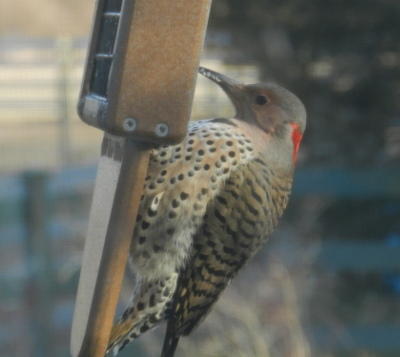
Bird of the Month: The Northern Flicker
NORTHERN FLICKERs are large, brown woodpeckers with a gentle expression and handsome black-scalloped plumage. On walks, don’t be surprised if you scare one up from the ground. It’s not where you’d expect to find a woodpecker, but flickers eat mainly ants and beetles, digging for them with their unusual, slightly curved bill. When they fly you’ll see a flash of color in the wings – yellow if you’re in the East, red if you’re in the West – and a bright white flash on the rump. That is to say that the "Yellow-shafted Northern Flicker" lives in the East and the "Red-shafted" lives out west. They will mate together where territories overlap.
Distinguishing males from females here in the east: both genders have red at the nape of the neck; the male has a black line - almost a moustache, extending from its bill to its neck.
Pictured is a female Yellow-shafted Flicker enjoying some suet during January's cold days. Notice how she uses her tail to support her weight as she dines. Also, note the yellow plumage at the base of its tail - hence the "yellow-shaft". These feathers are more visible in flight.
FUN FACTS
* Although it can climb up the trunks of trees and hammer on wood like other woodpeckers, the Northern Flicker prefers to find food on the ground. Ants are its main food, and the flicker digs in the dirt to find them. It uses its long barbed tongue to lap up the ants.
* Northern Flickers will visit suet feeders - especially in winter; seed feeders not so much.
* The red-shafted and yellow-shafted forms of the Northern Flicker formerly were considered different species. The two forms hybridize extensively in a wide zone from Alaska to the panhandle of Texas. A hybrid often has some traits from each of the two forms and some traits that are intermediate between them.
* The Northern Flicker is one of the few North American woodpeckers that is strongly migratory. Flickers in the northern parts of their range move south for the winter, although a few individuals often stay rather far north. Many mate only during Canadian summers!
* Northern Flickers generally nest in holes in trees like other woodpeckers. Occasionally, they’ve been found nesting in old, earthen burrows vacated by Belted Kingfishers or Bank Swallows. They may roost at night on the side of a tree or structure instead of inside a nesting cavity.
* Like most woodpeckers, Northern Flickers drum on objects as a form of communication and territory defense. In such cases, the object is to make as loud a noise as possible, and that’s why woodpeckers sometimes drum on metal objects. One Northern Flicker in Wyoming could be heard drumming on an abandoned tractor from a half-mile away.
* The oldest known yellow-shafted form of the Northern Flicker was a male and was at least 9 years, 2 months old when he was found in Florida.

